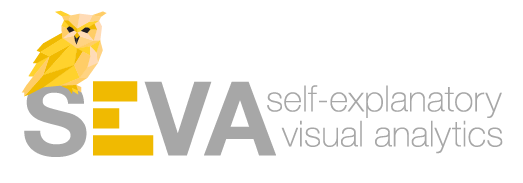Self-Explanatory Visual Analytics for Data-Driven Insight Discovery (SEVA)
Is a project in order to support users in learning novel visual data analysis tools more quickly, our main goal is to design and develop onboarding methods for visual analytics systems that can be automatically generated. With data journalism and biomedical R&D, we are targeting two diverse application domains. With appropriate onboarding methods the user experience as well as the understanding of visual data analysis tools for large and complex data sets will be enhanced. Methodologically, we will design, build, and evaluate proof-of-concept prototypes along an iterative user- and problem-oriented research process.

Project description
Increasing amounts of available data offer immense opportunities to promote technological, economic, and societal success in many domains, such as industry, biomedicine, or journalism. However, the possibilities to collect and store data increase at a faster rate than our ability to analyze and use it for decision making. Visual Analytics (VA) is an emerging area of research and practice that addresses this challenge by combining the outstanding visual perception and reasoning capabilities of humans with the strengths of automated data analytics of computers.
Albeit humans are visual beings and visual representations are easier to understand than other forms of data representation, users still need to learn how to read and comprehend them. For example, journalists or biomedical scientists are highly trained experts in their domains, but most of the users are not experts in VA and have difficulties in interpreting and working with novel visual representations or comprehend the characteristics of data analytics methods. This not only bears the risks of drawing wrong conclusions about the data or failing to tap into the power of data analytics but also leads to frustration or rejection of essentially powerful data tools. Adding to that, as VA is such a young and expanding discipline, a plethora of new VA approaches appear on a regular basis.
To address this challenge, visual analytics onboarding methods aim to help users to comprehend data visualizations and take full advantage of their tools at hand. This subject received very little attention from the scientific community so far. With respect to available products, solutions are mostly focusing on the overall UI rather than the visual representations. Moreover, such help systems need to be custom built and are laborious to create. Thus, they add an economic burden, particularly to small and medium enterprises. Empowering users with visual analytics onboarding is not only an open research challenge but also crucial for software solution providers. The two company partners in the project consortium provide VA tools for biomedical specialists as well as data journalists. Getting users of visual data tools up to full speed as quickly as possible is a key challenge that both companies face on the market. Being able to apply this technology in their products would be a substantial market advantage with the main benefits of increased user satisfaction and output quality at moderate cost.
Aims and implementation
The aim of this project is to create appropriate onboarding methods for VA tools that can be automatically generated. Our vision are self-explanatory VA tools that actively support users in interpreting visualizations and analytic methods. Results will be a conceptual framework of VA onboarding, proof-of-concept implementations, as well as use cases in biomedicine and journalism.
We will follow a user-centered and problem-driven design science research approach. Our research will be informed by cognitive science theory in a transdisciplinary manner. From a technical perspective, we will build on top of declarative specifications (visualization & data analytics grammars) and propose a novel method to automatically generate onboarding idioms. By involving software companies from two very different application areas, we ensure the relevance and generalizability of our novel technological approach. Thus, we address both, highly innovative scientific research as well as strong practical relevance.
Contact
- Štefan Emrich
datavisyn GmbH:
- Marc Streit
- Dominic Girardi
- Holger Stitz
- Daniela Moitzi
FH JOANNEUM:
- Eva Goldgruber
- Robert Gutouning
- Sonja Radkohl
TU Wien:
- Margit Pohl
- Benjamin Potzmann
- TU Wien
- FH JOANNEUM
- dwh GmbH
- datavisyn GmbH

